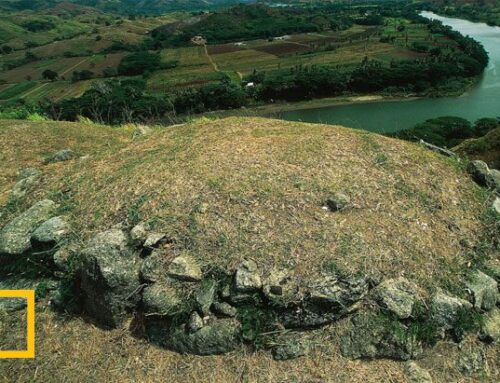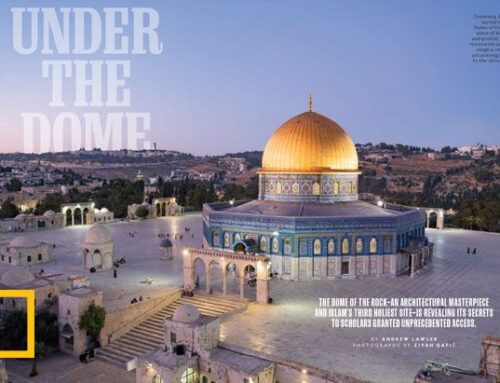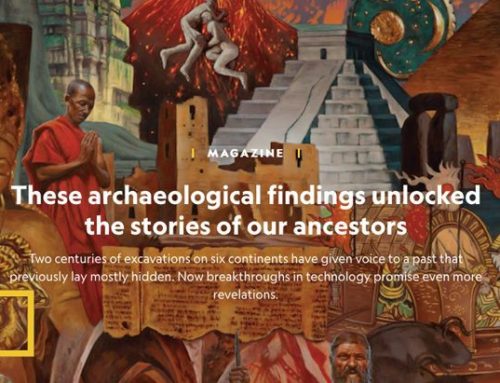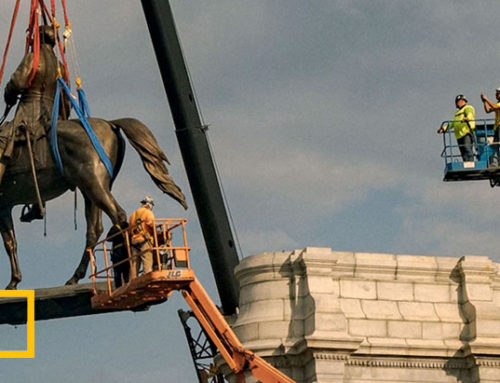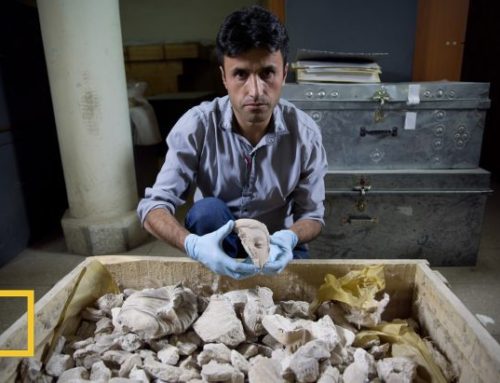A small band of Syrian villagers fight poverty, war, and the elements to protect an ancient site.
Amid the death, despair, and destruction that mark today’s Syria, there’s little good news for archaeologists and others who fear for the country’s remarkable cultural heritage. But in a windswept corner of the country, a dedicated group of local people is quietly protecting an important archaeological site, often at their own expense.
The high mound of Tell Mozan, which towers nearly 90 feet (27 meters) above the plain just three miles (5 kilometers) from the Turkish border in northern Syria, has so far escaped the looting, fighting, and religious extremism that have laid waste to so much of the region. The 2011 uprising against the Assad regime morphed into a fierce and protracted fight among competing factions.
“We were not expecting war,” says Giorgio Buccellati, an archaeologist from the University of California, Los Angeles, who began work at the site in the 1980s. He stopped work in late 2010 and planned to come back the following year. “We weren’t thinking that we faced a prolonged absence.”
Buccellati had good reason to return quickly. Shortly before the conflict began, his team uncovered intriguing evidence that Tell Mozan marked the start of a unique urban society that appears different from the cities that sprang up in southern Mesopotamia in today’s Iraq.
Archaeologists long thought that city life first developed in those southern settlements around 3500 B.C. and then spread to the north. But the finds at Tell Mozan, along with those at nearby sites, suggest that northerners had their own competing vision for urban life.

This unusual statue unearthed at Urkesh dates to about 2400 B.C. and may represent a spirit of the underworld in the Hurrian pantheon.
PHOTOGRAPH BY KENNETH GARRETT, NATIONAL GEOGRAPHIC CREATIVE
Excavations have been on hold as the war plays itself out. Though violence has flared to the southeast, in the town of Tell Brak, the local staff at Tell Mozan say their villages remain quiet.
Nevertheless, the site, like all of Syria, remains off limits to foreign archaeologists. But half a dozen local men who worked on the excavations remain, ensuring the site’s security and maintaining the fragile mud brick walls that make up much of the ancient settlement.
“The site is still in good condition,” says Kameran A., one of the local staff, via email. Kameran, like his coworkers, requested that his last name not be used for fear of becoming a target of violence.
Another, Diadin M., adds that the real enemy at Tell Mozan is not marauding armies or Islamist iconoclasts, but rain, snow, and extreme temperatures. “These natural factors are what threaten the site,” he says. If the archaeological remnants can’t be protected, “then the efforts of the last 30 years will be wasted.”
Discovering a Lost City
Buccellati long suspected that Tell Mozan was ancient Urkesh, an important city that was a sacred center to the Hurrians, a people of unclear origins who influenced the later Hittite Empire the way the Greeks influenced Rome.
Two famous bronze lions—one now in Paris’ Louvre and the other at the Metropolitan Museum in New York—were sold in the 1940s in Amuda, a nearby market town. Each bears the inscription: “The king of Urkesh built the temple of the lion.”
Buccellati and his team uncovered a similar stone lion in a religious sanctuary at Tell Mozan, but without an inscription.
Then the excavators came upon clinching evidence: a treasure trove of personal seal impressions on clay, one of which read “Tupkish, king of Urkesh” and dating to about 2250 B.C. Dozens of others mentioned his queen Uqnitum. Scholars suspect she was royalty from the Akkadian Empire that controlled much of Mesopotamia at the time.
The team also uncovered a vast plaza in front of the temple terrace in the middle of the mound, and an impressive sweep of stone stairs leading up to the platform, where Buccellati identified both a temple and, at the other end of the plaza, a palace. The dramatic architecture is notably different from that found to the south.
More recently the excavators began probing underneath the third millennium B.C. levels and hit on the corner of a building that, Buccellati says, “is almost certainly a temple.” Seal impressions, ceramics, and radiocarbon dates show that it was used around 3500 B.C., at the same time that the first monumental buildings were built in southern Mesopotamia.
It’s a model of urbanism, but different from that of Sumer,” the land close to the Persian Gulf, he says. What makes the find so exciting, he adds, is that it is located in a spot on the human-built mound that is still 72 feet (22 meters) above the plain—which means there may be even older structures underneath.

More than 4,000 years old, this paved floor and beehive oven were once part of a busy bakery in Urkesh. Situated on the edge of the north Mesopotamian plain, the city provides archaeologists with a unique glimpse into a long-vanished culture.
PHOTOGRAPH BY KENNETH GARRETT, NATIONAL GEOGRAPHIC CREATIVE
Keeping Hope Alive
To ensure that archaeologists will have a chance to probe deeper into the mound and Syria’s past, Buccellati is doing what he can to support the efforts of the Tell Mozan workers. But obtaining and transferring funds for wages and supplies is difficult, he says.
Sanctions imposed by Western countries on the Syrian government complicate efforts to funnel money into the country.
Before the war, the team constructed large curtains strung on metal frames to protect the fragile ancient walls from the wind and rain, but they require constant maintenance. Team members say they have been able to find local burlap and plastic sheets to patch torn areas, sometimes digging into their own pockets to advance money for urgently needed supplies.
“I bought, from my own funds, supplies such as thread and needles,” says Ibrahim K. The men say that while there has been no fighting in the vicinity, the economic situation is dire, food and medicine is expensive when they are available, and many people are leaving.
Buccellati remains optimistic that Syrians such as the villagers around Tell Mozan will protect archaeological sites that they know will benefit them in the future. Before the war, he planned to help create an eco-archaeological park around the site to attract tourists and provide local women with potential buyers for handicrafts. He hopes to still do so once peace prevails.
Until then, he and other archaeologists can only hope that Syrian pride in their ancient heritage will ensure that at least some of the country’s past will emerge from the conflict intact, ready to reveal many still-buried secrets.

